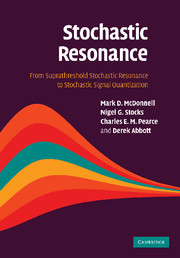Book contents
- Frontmatter
- Contents
- List of figures
- List of tables
- Preface
- Foreword
- Acknowledgments
- 1 Introduction and motivation
- 2 Stochastic resonance: its definition, history, and debates
- 3 Stochastic quantization
- 4 Suprathreshold stochastic resonance: encoding
- 5 Suprathreshold stochastic resonance: large N encoding
- 6 Suprathreshold stochastic resonance: decoding
- 7 Suprathreshold stochastic resonance: large N decoding
- 8 Optimal stochastic quantization
- 9 SSR, neural coding, and performance tradeoffs
- 10 Stochastic resonance in the auditory system
- 11 The future of stochastic resonance and suprathreshold stochastic resonance
- Appendix 1 Suprathreshold stochastic resonance
- Appendix 2 Large N suprathreshold stochastic resonance
- Appendix 3 Suprathreshold stochastic resonance decoding
- References
- List of abbreviations
- Index
- Biographies
7 - Suprathreshold stochastic resonance: large N decoding
Published online by Cambridge University Press: 23 October 2009
- Frontmatter
- Contents
- List of figures
- List of tables
- Preface
- Foreword
- Acknowledgments
- 1 Introduction and motivation
- 2 Stochastic resonance: its definition, history, and debates
- 3 Stochastic quantization
- 4 Suprathreshold stochastic resonance: encoding
- 5 Suprathreshold stochastic resonance: large N encoding
- 6 Suprathreshold stochastic resonance: decoding
- 7 Suprathreshold stochastic resonance: large N decoding
- 8 Optimal stochastic quantization
- 9 SSR, neural coding, and performance tradeoffs
- 10 Stochastic resonance in the auditory system
- 11 The future of stochastic resonance and suprathreshold stochastic resonance
- Appendix 1 Suprathreshold stochastic resonance
- Appendix 2 Large N suprathreshold stochastic resonance
- Appendix 3 Suprathreshold stochastic resonance decoding
- References
- List of abbreviations
- Index
- Biographies
Summary
The aim of this chapter is to find asymptotic large N approximations to the mean square error distortion for the suprathreshold stochastic resonance model. In particular, we are interested in how the distortion varies with noise intensity and how it scales with the number of threshold devices. That is, does the distortion become asymptotically small for large N?
Introduction
Chapter 6 developed the idea of treating the SSR model as a lossy source coding or quantization model. We saw that such a treatment requires specification of reproduction points corresponding to each of the N + 1 discrete output states. Once specified, an approximate reconstruction of the input signal can be made from a decoding, and the average error between this approximation and the original signal subsequently measured by the mean square error (MSE) distortion. We saw also in Chapter 5 that asymptotic approximations to the output probability mass function, Py(n), output entropy, average conditional output entropy, and mutual information can be found if the number of threshold devices, N, in the SSR model is allowed to become very large. The aim of this chapter is to again allow N to become very large, and develop asymptotic approximations to the MSE distortion for the cases of optimal linear and optimal nonlinear decodings of the SSR model.
Chapter structure
This chapter has three main sections. We begin in Section 7.2 by letting N become large in the formulas derived in Chapter 6 and analyzing the result. Next, Section 7.3 takes the same approach from the estimation theory perspective.
Information
- Type
- Chapter
- Information
- Stochastic ResonanceFrom Suprathreshold Stochastic Resonance to Stochastic Signal Quantization, pp. 233 - 247Publisher: Cambridge University PressPrint publication year: 2008
